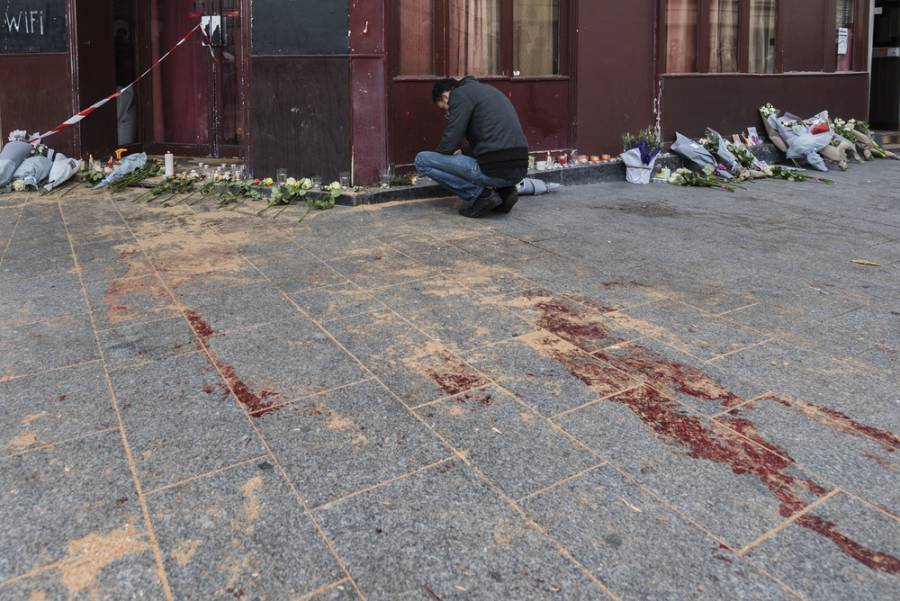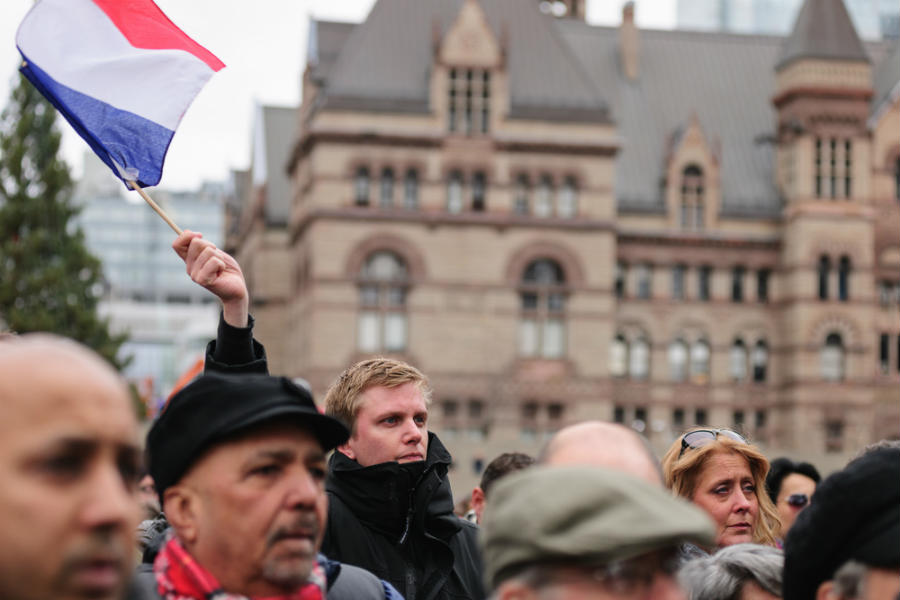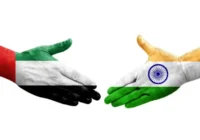The atrocities in Paris confirm a long-term trend in the evolution of terrorist tactics in Europe—toward attacks that are harder to prevent.
The attack in Paris on November 13 is representative of a longer-term evolution of terrorist tactics over the past decade that has become more pronounced during 2015. The attack, which was claimed by the Islamic State (IS) and killed at least 129 people while wounding 352 others, confirms that militant groups are now carrying out operations that are more sophisticated and difficult to prevent.
Since the 2004 Madrid and the 2005 London bombings, attacks in Europe have evolved from complex bomb plots with a high likelihood of failure to attacks involving a combination of suicide bombings, assault weapons and hostage taking. Attacks have become extended over several days involving multiple terror cells working in tandem. Further evidence of this was seen on November 18, when security forces in Paris engaged heavily armed suspects in the northern suburb of Saint-Denis almost five days after the initial attack. The confrontation saw one suspect detonate a suicide vest and others engaging police in a prolonged shootout in what initial reports indicate was a raid on the mastermind of the initial attacks, Abdelhamid Abaaoud.
The transnational qualities of the Paris attacks—which were planned in Syria, organized in Belgium and carried out in France—underscore the vulnerabilities Europe is exposed to. The attacks required sophisticated information and knowledge sharing, the undetected movement of operatives, the building of sophisticated explosive devices most likely in Europe, and the procurement of an arsenal of assault weapons, also likely from within Europe. Most notably, the operation was carried out by foreign fighters in a highly alert European security environment, with several of the perpetrators already known to French, Belgian and Turkish security agencies amid increased monitoring of nationals traveling to Middle Eastern warzones. Witness reports suggested that the attackers killed people calmly and systematically, exhibiting skills likely learned and strengthened during combat operations in Syria.
The methods used in Paris, which involved three teams of militants attacking six sites, strongly resemble those used frequently in warzones in Iraq, Syria, Afghanistan and Pakistan that have been increasingly replicated in urban areas worldwide.
In 2008, a group of ten Pakistan-based jihadists carried out a prolonged attack targeting six locations across central Mumbai, India, killing 166 people using a range of assault weapons. In June 2014, a group of ten terrorists armed with suicide vests, grenades and assault rifles attacked the Jinnah International Airport in Karachi, Pakistan, prompting protracted clashes with security forces that ultimately led to the deaths of at least 29 people.
Similar attacks have also been carried out on multiple occasions in Kabul, Afghanistan, where a group of six terrorists armed with suicide vests, automatic weapons, rocket-propelled grenades and a car bomb staged an attack near the city’s airport in July 2014. The death tolls in these incidents have ranged from tens to hundreds, with the most deaths caused by small arms.
Outside the Middle East and South Asia, the increasing use of assault weapons to attack soft targets is similarly clear. Five attacks in France, an attack in Belgium and two attacks in Tunisia between 2012 and 2015 have all been carried out with a range of assault weapons, killing more than 200 people and injuring hundreds more. The targets selected were often civilian locations deemed “soft” targets that would inflict mass casualties, such as restaurants, tourist sites and crowded urban areas. Although the circumstances of these various attacks are evidently distinct, the parallels between them illustrate a growing recognition of their effectiveness and impact among militant groups around the world.
Islamic State brings warzone tactics to Europe
In the European context, combining assault weapons with explosives and hostage taking has allowed militants to spread the impact of an assault across a city, prolonging attacks from several hours to several days. For instance, although the latest attacks were concentrated on November 13, heavily armed jihadists were still being killed and detained in a raid five days later. Such tactics also decentralize the security response, increase casualty figures and elevate the assaults’ media exposure.
The January 2015 attacks in Paris, which involved multiple incidents over three days after the initial shooting at the offices of the Charlie Hebdo satirical newspaper, demonstrated the effectiveness of such tactics in a major European capital and highlighted the potential for a much higher death toll than may have been originally anticipated.
The attacks on November 13 now reflect the first full adoption of warzone-style terrorist tactics in a European theater and illustrate their destructive impact. The high casualty rates came despite an improved response by French security forces, who had since January trained extensively for the type of Mumbai-style scenario that ultimately unfolded. It should also be noted that the Islamic State remains on a learning curve and attacks have the potential to become more deadly; the detonations of the suicide vests largely failed to cause mass casualties and were primarily used by the attackers to avoid capture. Had any of the three suicide bombers near the packed Stade de France football stadium successfully entered the match in progress, the death toll may have been significantly higher.
Information and responses surrounding attacks will continue to develop over the coming weeks, with the situation likely to remain fluid as security services and governments take action against suspects and debate a European-wide response to the threat posed by Islamic State. As security agencies conduct investigations and arrests, more information regarding the size and extent of networks involved in the terrorist attacks will be revealed, allowing a more accurate assessment of the threat.
Confirmation of the origins of the weapons and explosive devices used in the attacks will offer further insights into the scale of Islamic State’s reach within Europe. Initial findings have already raised concerns over the Islamic State’s capability and aspirations to orchestrate simultaneous attacks across multiple countries in the future. In the week prior to the events in Paris, a man potentially linked to the attacks was arrested in Germany in possession of eight assault rifles, three handguns and explosives, while Turkish authorities said they had foiled a major attack in Istanbul allegedly led by British Islamic State militant Aine Lesley Davis, also planned for November 13.
Attacks to elicit transnational response
The Paris attacks will have a sweeping impact on European security measures and freedom of movement, but the threat of terrorism will persist and likely worsen in the short-term. France intensified air strikes against the Islamic State in Syria immediately after the attacks, and further intensification of Western campaigns in the region will heighten the risk of retaliation in European cities. On November 17, France—for the first time in the European Union’s (EU) history—invoked article 42.7 of the Lisbon Treaty, which obligates member states to offer France “aid and assistance by all means in their power” in case of “armed aggression.” Although the legal basis for the implementation of the article is uncertain, the clause would require EU countries to increase military participation in theaters where the French military operates. Several senior European officials have also said that France would be justified to invoke Article 5 of the NATO treaty governing collective self-defense, a move that could prompt a far wider response against Islamic State.
A political resolution to the Syrian conflict will be key to combating terrorism in Europe in the long-term, but achieving such an outcome remains uncertain as the US, EU countries, Russia and Iran negotiate over competing regional interests. Moreover, an intensification in fighting—as seen following Russia’s commencement of air strikes in Syria in September—is likely to exacerbate the ongoing refugee crisis in Europe, which has already seen more than 750,000 people enter the continent in 2015.
In a direct response to the transnational nature of the attacks, France announced on November 16 that it would call for a suspension of Europe’s Schengen Agreement, which guarantees freedom of movement within most of the EU. Reports that one of the attackers in Paris had entered Greece before traveling to France using a Syrian passport will further fuel concerns over the security implications of the refugee crisis. This will exacerbate an already sharp political and public backlash against the flow of migrants into Europe. Should restrictions to the freedom of movement go ahead across Europe, this will have profound implications for European transits and will be seen as a reversal of one of the EU’s cornerstones. Any reintroduction of national border checks at all ports of entry will cause significant delays to land-based travel as well as lesser delays to air transits, amid questions around the measures’ effectiveness for preventing further attacks.
Anti-Muslim backlash likely
As witnessed already in the wake of the Charlie Hebdo attacks, France and Europe more broadly are likely to witness a spike in xenophobic crime and anti-Muslim protests. On November 15, right-wing protesters disrupted a solidarity march in Lille, calling for Muslims to be expelled from France. On November 16, an estimated 9,000 anti-Muslim protesters from PEGIDA, the Patriotic Europeans Against the Islamization of the Occident movement, marched in Dresden blaming Europe’s immigration policies for the attacks.
Shootings, assaults and cases of vandalism targeting Muslims and places of worship around France, akin to those seen after the Charlie Hebdo assault, remain highly likely in the weeks ahead.
Increased intelligence monitoring
The attacks will prompt a review of intelligence practices and increased police and defense spending. France already announced on November 16 that it would prohibit cutbacks in the police and the military until 2019 and recruit 5,000 more police officers over the next two years, despite the fact that these measures will violate EU spending regulations. However, intelligence vulnerabilities laid bare by the November 13 attacks are unlikely to be patched by these measures in the medium-term.
Security services will have increased the monitoring of jihadist suspects and sympathizers since the January attacks, but the limitations of these efforts were highlighted when individuals already on French watch lists were confirmed to have participated in the latest plot. The fact that at least two of the attackers were French nationals and three were Belgian, including alleged mastermind Abdelhamid Abaaoud, illustrates the home-grown roots of the threat despite planning taking place in the Islamic State’s heartland in Syria.
However, closer intelligence sharing between Western powers has the potential to lead to some short-term successes, and is likely to see a swathe of terrorism-related arrests in the coming weeks and months. In the immediate aftermath of the attacks, French and Belgian authorities arrested more than 100 people in more than 170 separate raids, seizing a range of weapons including assault rifles and rocket-propelled grenades. The scale of the arrests, however, suggests many of those detained are unrelated to the attacks and many have already been released without charge.
The November 18 raid on a heavily armed group of jihadists in Saint-Denis that led to the killing of two suspects, including one during the detonation of a suicide vest, also indicates that armed jihadist cells may still be present in the French capital.
Monitoring returning foreign fighters and the networks within which these individuals are embedded in Europe will remain a cornerstone of Western counterterrorism policy, but the risk of attack will nonetheless remain elevated. At least three of the identified French and Belgian attackers had traveled to fight in Syria and subsequently returned to their home countries, illustrating the threat posed by the estimated 3,000-5,000 European foreign fighters thought to be in Syria and Iraq. This will leave Europe exposed to further such attacks, focusing on similarly “soft,” civilian targets and prompting the temporary introduction of disruptive security restrictions, particularly in the short-term.
The evolution of the terrorist threat to its current form—sophisticated and hard-to-detect attacks on civilians executed using assault weapons, suicide bombings and hostage taking—represents a notable turn in European security. Governments across Europe have been shaken by the Paris attacks and are taking unprecedented action to assess and combat the threat posed by the Islamic State. However, without a political resolution of the Syrian conflict, home-grown jihadists of the Islamic State will retain the ability to stage further attacks on the continent.
*[This article is based on a report published by Protection Group International.]
The views expressed in this article are the author’s own and do not necessarily reflect Fair Observer’s editorial policy.
Photo Credit: Frederic Legrand – COMEO / Stacey Newman / Shutterstock.com
 We bring you perspectives from around the world. Help us to inform and educate. Your donation is tax-deductible. Join over 400 people to become a donor or you could choose to be a sponsor.
We bring you perspectives from around the world. Help us to inform and educate. Your donation is tax-deductible. Join over 400 people to become a donor or you could choose to be a sponsor.
Support Fair Observer
We rely on your support for our independence, diversity and quality.
For more than 10 years, Fair Observer has been free, fair and independent. No billionaire owns us, no advertisers control us. We are a reader-supported nonprofit. Unlike many other publications, we keep our content free for readers regardless of where they live or whether they can afford to pay. We have no paywalls and no ads.
In the post-truth era of fake news, echo chambers and filter bubbles, we publish a plurality of perspectives from around the world. Anyone can publish with us, but everyone goes through a rigorous editorial process. So, you get fact-checked, well-reasoned content instead of noise.
We publish 2,500+ voices from 90+ countries. We also conduct education and training programs
on subjects ranging from digital media and journalism to writing and critical thinking. This
doesn’t come cheap. Servers, editors, trainers and web developers cost
money.
Please consider supporting us on a regular basis as a recurring donor or a
sustaining member.
Will you support FO’s journalism?
We rely on your support for our independence, diversity and quality.








